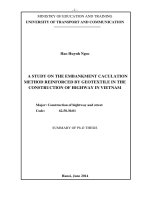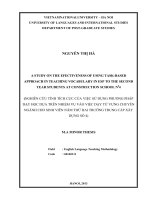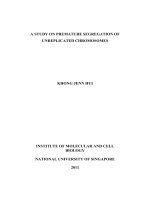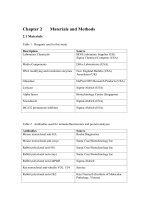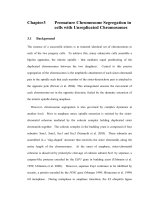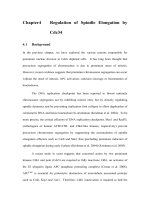A study on vegetative propagation of Huperzia serrata by cuttings in Sa Pa, Lao Cai
Bạn đang xem bản rút gọn của tài liệu. Xem và tải ngay bản đầy đủ của tài liệu tại đây (508.67 KB, 7 trang )
ACADEMIA JOURNAL OF BIOLOGY 2019, 41(3): 107–113
DOI: 10.15625/2615-0923/v41n3.13921
A STUDY ON VEGETATIVE PROPAGATION OF Huperzia serrata
BY CUTTINGS IN SA PA, LAO CAI
Le Thi Lan Anh1, Bui Tuan Anh3, Giang Xuan Sang3, Ton That Huu Dat4,
Ho Thi Huong2, Nguyen Duc Thanh1,2,*, Le Thi Bich Thuy1,2
1
Graduate University of Science and Technology, VAST, Vietnam
2
Institute of Biotechnology, VAST, Vietnam
3
Hoang Lien National Park, Lai Chau, Vietnam
4
Mientrung Institute for Scientific Research, VAST, Vietnam
Received 8 July 2019, accepted 16 August 2019
ABSTRACT
Huperzia serrata is a precious medicinal plant used in medicine to support and treat Alzheimer's
disease. Currently, this species is in danger of extinction due to indiscriminate exploitation for
commercial purposes. Furthermore, this species reproduces slowly and is difficult to cultivate
artificially. The reproduction by spores of this species is very long and takes 15−20 years from
the spore germination to mature plant, whereas asexual reproduction by tissue culture is also
difficult. Therefore, cutting is an effective method to propagate this species on a large scale. In
this study, we surveyed the factors affecting the survival rate, the rooting and the number of new
leaves of the stem cuttings, including cutting length, growing substrate, and effects of growthregulating hormones IBA (0 ppm, 500 ppm, 1000 ppm, 2000 ppm and 3000 ppm) and α-NAA (0
ppm, 10 ppm, 20 ppm, 30 ppm and 40 ppm). The experimental results showed that using cuttings
of 6 cm in length treated with IBA at a concentration of 1000 ppm for 30 mins and cultured on
the substrate mixture of soil, decomposed animal manure and rice husk at a ratio of 3:1:1 was the
best for cuttings of H. serrata in Sa Pa. The results of this study will contribute to the
conservation and development of genetic source of H. serrata in Vietnam.
Keywords: H. serrata, cutting, IBA, regulating hormones, NAA, propagation.
Citation: Le Thi Lan Anh, Bui Tuan Anh, Giang Xuan Sang, Ton That Huu Dat, Ho Thi Huong, Nguyen Duc Thanh,
Le Thi Bich Thuy, 2019. A study on vegetative propagation of Huperzia serrata by cuttings in Sa Pa, Lao Cai.
Academia Journal of Biology, 41(3): 107–113. />*
Corresponding author email:
©2019 Vietnam Academy of Science and Technology (VAST)
107
Le Thi Lan Anh et al.
INTRODUCTION
H. serrata is a precious medicinal plant in
the red list of the Program of research on
conservation and development of rare and
precious gene sources for medicinal plants
(Nong Van Duy, 2015). This plant has many
medical
effects,
especially
dementia
(Alzheimer) of the elderly. At present, this
plant is being indiscriminately procured and
exploited, leading to a decline in this precious
medicinal resource in nature. Hence, studies
on H. serrata are receiving the concern of
many countries in the world, including
Vietnam.
The reproduction of H. serrata is a
combination of sexual and asexual
reproduction (Whittier et al., 2007). Similar to
other species of genera Huperzia and
Lycopodium, the spore germination process of
H. serrata is poor under controlled conditions.
The gametophytes and sporophytes of this
species are often long-lived and grow slowly
in an environment having high relative
humidity and abundant organic matter;
therefore, it is difficult to propagate (Ma et al.,
2006). Studies show that spores of species
belonging to the genus Huperzia take 2−5
years to develop into sporophytes (Whitter et
al., 2007). This development process in H.
serrata is much slower and usually requires
15−20 years of growth since spore
germination to maturity (Ferreira et al., 2016).
Thus, the spore germination methods of H.
serrata in soil environment or sterile culture
media are not-yet performed. Although
vegetative propagation of H. serrata by tissue
culture has been successful in the world, it is
difficult to obtain large biomass and requires a
long time (Ma et al., 2008; Ma et al., 2015;
Manpreet et al., 2016). Moreover, the process
of transf����������������������������������������������������������������������������������������������������������������������������������������������������������������������������������������������������������������������������������������������������������������������������������������������������������������������������������������������������������������������������������������������������������������������������������������������������������������������������������������������������������������������������������������������������������������������������������������������������������������������������������������������������������������������������������������������������������������������������������������������������������������������������������������������������������������������������������������������������������������������������������������������������������������������������������������������������������������������������������������������������������������������������������������������������������������������������������������������������������������������������������������������������������������������������������������������������������������������������������������������������������������������������������������������������������������������������������������������������������������������������������������������������������������������������������������������������������������������������������������������������������������������������������������������������������������������������������������������������������������������������������������������������������������������������������������������������������������������������������������������������������������������������������������������������������������������������������������������������������������������������������������������������������������������������������������������������������������������������������������������������������������������������������������������������������������������������������������������������������������������������������������������������������������������������������������������������������������������������������������������������������������������������������������������������������������������������������������������������������������������������������������������������������������������������������������������������������������������������������������������������������������������������������������������������������������������������������������������������������������������������������������������������������������������������������������������������������������������������������������������������������������������������������������������������������������������������������������������������������������������������������������������������������������������������������������������������������������������������������������������������������������������������������������������������������������������������������������������������������������������������������������������������������������������������������������������������������������������������������������������������������������������������������������������������������������������������������������������������������������������������������������������������������������������������������������������������������������������������������������������������������������������������������������������������������������������������������������������������������������������������������������������������������������������������������������������������������������������������������������������������������������������������������������������������������������������������������������������������������������������������������������������������������������������������������������������������������������������������������������������������������������������������������������������������������������������������������������������������������������������������������������������������������������������������������������������������������������������������������������������������������������Le Thi Lan Anh et al.
other lengths at the statistical significance of
95% and high reliability of 2.3% and 2.4%,
respectively. These results revealed that the
use of the cuttings of 6 cm in length gave the
best efficiency for the propagation of H.
serrata. This result is consistent with the
previous study described by Long et al.
(2014). Authors propagated H. serrata by
cuttings method in the Yantuozhai region's
forest farm and showed that the cuttings of 6
cm in length gave the best efficiency.
Therefore, the cuttings with the length of 6 cm
were used for further experiments.
Table 1. Effect of cutting length on the growth of H. serrata after 4 months
Cutting length Survival rate (%) Rooting rate (%) Rate of cuttings with new leaves (%)
4 cm
74.72c
10.04e
32.74d
b
d
5 cm
78.06
17.79
47.71c
6 cm
86.39a
23.47a
68.49a
7 cm
88.33a
21.39c
65.41b
8 cm
86.94a
22.36b
67.73ab
9 cm
87.22a
21.98bc
65.29b
a
c
10 cm
86.62
21.47
67.64ab
CV %
1.5%
2.3%
2.4%
5% LSD
2.284
0.799
2.55
Note: The different letters in a column indicated significantly difference at P < 0.05.
Effect of substrates on the propagation of
H. serrata
According to Ninh Thi Phip (2013),
planting substrates have a great influence on
the ability to propagate plants. In propagation
by cuttings, the substrates have the function of
holding the cuttings in fixed positions and
provide sources of water and nutrients for the
cuttings. Furthermore, the substrates allow air
to penetrate the base of cuttings. A good
substrate must have sufficient porosity, good
aeration, water retention and drainage
capacity, no pests and weeds. The previous
studies have shown that the most favorite
environment for cuttings of H. serrata is the
ecological forest environment (Zhang et al.,
2009; Long et al., 2014). Therefore, in this
study, we used forest soil as the main
substrate and supplemented with manure, rice
husk and vermicompost at different ratios to
find the best substrate mixture for cuttings of
H. serrata. At the same time, on the basis of
previous experiment result, the cuttings of 6
cm in length were used. The experimental
results are presented in table 2.
110
The growth parameters of the cuttings
using substrate mixtures supplemented with
manure were higher than those of the control
substrate. This suggests that increasing the
porosity and nutrients of the substrates can
enhance the growth ability of H. serrata. The
survival rate of substrate mixtures CT2
(88.89%) and
CT3 (89.72%)
were
significantly higher than that of other
substrate mixtures. Although the survival rate
of CT3 was higher than that of CT2, this
difference was not statistically significant.
Moreover, rooting rate (29.07%) and rate of
cuttings with new leaves (83.44%) of CT2
substrate mixture were significantly higher
than those of other substrate mixtures. It was
observed that rooting rate was positively
correlated to the rate of cuttings with new
leaves, indicating a two-way relationship
between root and leaf growth. The root
growth supported for taking nutrients and
water from the habitat to the plant and
enhanced the growth of leaves. At the same
time, the growth of leaves helped the plant
grow and synthesize vegetative nutrients and
promoted root growth. The CT2 mixture with
A study on vegetative propagation
a combination of forest soil, decomposed
animal manure and rice husk that made the
substrates soft, nutritious, and moist shows the
most favorable for cuttings of H. serrata.
Table 2. Effect of substrates on the growth of H. serrata cuttings after 4 months
Survival rate
Rooting rate
Rate of cuttings with new
Substrate mixture
(%)
(%)
leaves (%)
b
c
Control (forest soil)
86.39
23,47
68.49cd
b
b
CT1
87.5
25.71
69.85c
CT2
88.89a
29.07a
83.44a
CT3
89.72a
24.77b
70.90b
CT4
86.94b
24.92b
67.41d
CV%
0.7
3.2
1.6
5% LSD
1.18
1.552
2.187
Note: The different letters in a column indicated significantly difference at P < 0.05.
Effect of the growth-regulating hormones
IBA and α-NAA on the growth of H. serrata
cuttings
The addition of growth-regulating
hormones plays an important role in
increasing survival, root and shoot growth
rates. Ninh Thi Phip (2013) suggested that
using auxin to stimulate the growth of cutting
root would improve the rate of plant growth.
The effective auxin concentration used for
herbaceous and softwood was less than 1000
ppm, and for half-hard woody plants was
2000 - 3000 ppm. On the other hand, Zhang et
al. (2009) reported that IBA concentration of
2000 ppm gave the best effect for H. serrata
cuttings. According to Qin et al. (2010),
shoots of H. serrata before cuttings were
soaked in IBA solution of 1000 ppm for 30
mins gave a high survival rate up to 93−98%
and rooting rate reached 98%. In addition,
Long et al. (2014) using H. serrata cuttings of
6 cm length soaked in α-NAA solution of 20
ppm for 5 mins gave a high survival rate up to
90% and rootlets of cuttings appeared only
after 60 days of planting. In this study, we
used cuttings of 6 cm in length treated with
two growth-regulating hormones IBA and αNAA with different concentrations and
treating times, then planted in the CT2
substrate. The experimental results are
presented in table 3.
The experimental results showed that H.
serrata grew better in the forest soil
environment; therefore, the growth of roots
and new leaves of the cuttings were also
observed
when
no
growth-regulating
hormones added. However, when IBA was
used, number of roots and new leaves
significantly increased. Especially, number of
roots (2.38 ± 0.06) and new leaves (2.61 ±
0.06) of the cuttings were the best when the
cuttings were treated with IBA at a
concentration of 1000 ppm. At a
concentration of 2000 ppm, number of roots
(2.07 ± 0.05) and new leaves (2.43 ± 0.07)
significantly decreased. As a consequence,
treatment of the cuttings with IBA at a
concentration of 1000 ppm for 30 mins before
cutting was most suitable.
For the cuttings treated with α-NAA, the
growth of cuttings significantly increased
compared to the cuttings without treatment of
α-NAA. In particular, cuttings treated with αNAA at a concentration of 20 ppm for 5 mins
gave the highest number of roots (1.97 ± 0.06)
and new leaves (2.33 ± 0.07). However, when
comparing the promoting efficiency of αNAA and IBA on the growth of H. serrata
roots and leaves, α-NAA was less effective
than IBA. Therefore, the treatment of cuttings
with IBA at a concentration of 1000 ppm for
30 mins was proven to be the best for H.
serrata cutting propagation.
111
Le Thi Lan Anh et al.
Table 3. Effect of the growth-regulating hormones IBA and α-NAA
on the growth of H. serrata cuttings after 4 months
Hormones Concentration (ppm)
Number of roots
Number of new leaves
0 (water)
1.36 ± 0.05a
1.58 ± 0.08a
500
1.42 ± 0.05b
1.64 ± 0.08b
IBA
1,000
2.38 ± 0.06d
2.61 ± 0.06d
e
2,000
2.07 ± 0.05
2.43 ± 0.07e
3,000
1.97 ± 0.06c
2.18 ± 0.09c
CV%
1.9
1.4
5% LSD
0.0494
0.0430
a
0 (water)
1.49 ± 0.05
1.98 ± 0.08a
c
10
1.69 ± 0.06
2.04 ± 0.08a
20
1.97 ± 0.06d
2.33 ± 0.07c
α-NAA
30
1.91 ± 0.06e
2.29 ± 0.08c
40
1.8 ± 0.07b
2.19 ± 0.08b
CV%
1.5
2.2
5% LSD
0.0505
0.0853
Note: the different letters in a column indicated significantly difference at P < 0.05.
CONCLUSIONS
The results of our study showed that the
cuttings of 6 cm in length treated with IBA at
a concentration of 1,000 ppm for 30 mins and
the substrate mixture of soil, decomposed
animal manure and rice husk at a ratio of
3:1:1 are the best materials for vegetative
propagation of H. serrata by cutting in Sa Pa.
The results of this study will contribute to the
conservation and development of genetic
source of H. serrata in Vietnam.
Acknowledgements: The work was funded by
the project supported by program on
conservation and sustainable use of genetic
resources of Ministry of Science and
Technology: “Exploitation and development
of genetic resources of Huperzia serrata
(Thunb) Trev in Sa Pa and Da Lat”.
REFERENCES
Ferreira A., Rodrigues M., Fortuna A., Falcao
A., Alves G. (2016). Huperzine A from
Huperzia serrata: a review of its sources,
chemistry, pharmacology and toxicology.
Phytochemistry Review, 15(1): 51–58.
112
Hoang Minh Tan, Nguyen Quang Thach,
1993. Plant growth-promoting hormones.
Agricultural Publisher, pp. 11–17.
Long H., Li Q., Li L., Huang L.H., 2014.
Study on cutting and gemmae propagation
of Huperzia serrata. Journal of Chinese
medicinal materials. 7(7): 1115–1121.
Ma X., Gang D.R., 2008. In vitro production
of Huperzine A, a promising drug
candidate for Alzheimer’s disease.
Phytochemistry, 69 (10): 2022– 2028.
Ma X., Tan C., Zhu D., Gang D. R., 2006. A
survey of potential Huperzine A natural
resources in China: the Huperziaceae. J.
of Ethnopharmacol, 104(1-2): 54–67.
Ma Y.Z., Liu J.H., Xu H., Liu F., 2015. In
vitro cultural of Huperzia serrata. Plant
Physiology Journal, 51(4): 465–470.
Manpreet K., Singh P., Kaur J., 2016. A
Systematic review on Huperzia serrata.
International Journal of Pharmacognosy
and Phytochemical Research, 8(8):
1250–1255.
Nguyen Quang Hieu, Nguyen Thanh Tung,
Vu Thu Thuy, Nguyen Viet Than, 2017.
A study on vegetative propagation
Study on the botanical characteristics of
two species of Huperzia (Lycopodiaceae).
Journal of Pharmacology, 4(492): 36–40.
Ninh Thi Phip, 2013. Techniques for
improving vegetative propagation rate of
Polyscias fruticosa (L.) Harms. Journal of
Science and Development, 11(2): 168–173.
Nong Van Duy, 2015. Situation of research on
H. serrata in Vietnam. Tay Nguyen
Publisher, pp. 7–12.
Qin D.J., Yang Y. K., Xiang J.Q., Zeng F.Z.,
Li Y.J., Yin H.Q., Zou Y.C., Ma J., 2010.
Study on cutting seedling NFT culture
technique of Huperzia serrata (Thunb.)
Trev. Journal of Hubei University for
Nationalities - Natural Science edition,
28(1): 18– 21.
Whittier D.P., Storchova H., 2007. The
gametophyte of Huperzia selago in
culture. American Fern Journal, 97 (3):
149–154.
Zhang J.C., Zhang H.Y., Ye Z.L., Ye X.H.,
Zhu M., 2009. Preliminary report of
Huperzia serrata nursery constructing and
original habitat cutting. Journal of
Sanming University, 26(2): 194−198.
113



